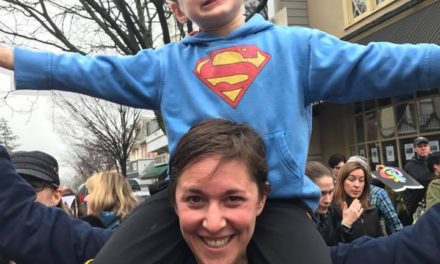We tend to think of ballerinas as petite, demure, good-natured darlings all polished up in pink. But 55-year-old Risa Kaplowitz says it’s the Teflon tomboys that often make the most successful ballerinas. And she would know. She spent decades of intensive training that began as a 3-year-old and culminated in many years in the spotlight as a dancer in premiere ballet companies in the Northeast. She eventually co-founded the Princeton Dance and Theatre Studio and the nonprofit Princeton Youth Ballet more than 13 years ago, which regularly turns out professional ballerinas. So Risa is as intimately connected to the world of professional ballet as anyone.
Gifted with natural grace, athleticism, and artistry that she paired with the grit, determination, and the grueling hard work it takes to become a professional ballerina, Risa started her training in preschool and never looked back.
She was 3 years old when a babysitter taught her some steps and encouraged her mom to bring her to the recreational center where she grew up in Silver Spring, Md. The teacher identified her raw talent right away—during her first class—and she soon found herself in her first ballet school, dancing with girls twice her age. “That set me on a path, which I never questioned until I became a professional ballerina at 17. It was at that time I realized I never really tried for anything else,” she says. “I got to a point where I put so much time and energy behind dancing that it became my home, and without it I would have been lost. My friends were at ballet, and my entire self-esteem was wrapped around being a dancer. That’s who I was.”
While there was little uncertainty in her youth that she would pursue becoming a professional dancer, Risa says the grind on the body and mind during her decades of training was intense. “Honestly, anything a dancer will do after a career in dance is a walk in the park. Literally anything,” she says. “There is nothing more difficult physically or cognitively—you have to take constant direction, change things on a director’s whim, learn everyone else’s parts, and then there’s the competitive aspect.”
 When she became a professional dancer, Risa says it was difficult to create and maintain friendships within the ballet world because there was so much competition. “It was hard to form really deep relationships. You need them desperately, but there are only so many roles in a ballet, and you’re constantly in competition with your best friend,” she says. “It’s not like Black Swan—nobody is going to razor blade your shoes or anything, but nobody’s really rooting for you either, and that means you have to swim upstream every day and do it pretty much by yourself.”
When she became a professional dancer, Risa says it was difficult to create and maintain friendships within the ballet world because there was so much competition. “It was hard to form really deep relationships. You need them desperately, but there are only so many roles in a ballet, and you’re constantly in competition with your best friend,” she says. “It’s not like Black Swan—nobody is going to razor blade your shoes or anything, but nobody’s really rooting for you either, and that means you have to swim upstream every day and do it pretty much by yourself.”
However, Risa says the world of ballet has changed profoundly over the years, in ways that make her feel good about regularly turning out professional dancers. During her dance career, Risa says doing anything outside of ballet was really frowned upon, including education, family planning, and even a social life. “There’s more recognition of the amount of work it takes and how smart and well rounded dancers have to be to be successful,” she says. “If you decided to get married or have kids, you are taken back into your rank when you get back. If you want to go to college—fabulous—they support you. In fact, some companies have arrangements with specific universities. There’s more support.”
Cold Turkey
When she was in her mid-20s, Risa was living in New York and dancing with Ballet Manhattan and touring all over the world. She was loving it, but her future was looming large in her mind—what would she be qualified to do? Just as the company was preparing for a tour in Turkey, and after more than two decades spending most waking hours dedicated to ballet, she stopped dancing.
After attending a workshop called Careers for Women, which piqued her interest in sales, Risa was hired at a company called Friden Alcatel selling postage meters in midtown Manhattan. “I went from being a principal ballerina to selling postage meters door to door in New York,” she recalls.
Risa describes leaving her dancing career so suddenly to an addict going cold turkey with drugs or alcohol. “During the transition, I cried every day. I was trying to figure out where I belonged.”
To keep a foot in the dancing world, Risa had a gig as a ballet mistress at Julliard and eventually started teaching advanced and professional dancers at a big studio in Manhattan in the Ed Sullivan Building. “I found teaching enabled me to use my voice and my brain and really put it all together.”
Risa put a personal ad in New York Magazine and met Alan Kaplowitz, an executive at Swiss Bank, who is now her husband of 22 years. She eventually landed jobs as a sales rep for Mikasa and Calvin Klein and moved from New York to Princeton to live with Alan. “I was ready to move out of New York. Have a suburban life. Be a mommy. Drive the minivan,” Risa says.
She and Alan married and had a son Brandon (now 21) and daughter Adrienne (now 16), and she learned to love the life of a suburban mom in Princeton. She took an adult ballet class to refresh the muscle memory and eventually started teaching. When Adrienne turned 4, she wanted to sign her up for ballet, and an idea began to form. That’s when a chance meeting brought it all into focus.
Born to (Teach) Dance
Fifteen years ago, Risa attended her first dance teacher’s 80th birthday party and ran into her old friend Susan Jaffe, who she had danced with throughout her training as a young girl. That meeting coincided with Susan’s retirement from the American Ballet Theatre where she was a principal for 22 years, ending a high-profile and acclaimed career in ballet. “When I saw Susan, I told her my idea to start a school, and she came with me to look at spaces. A few months later, we were here,” Risa says. “I pinch myself every day.”
They found a space in Forrestal Village in Princeton, where the school has been ever since, eventually modifying the studio to better accommodate their growing needs. With Susan’s impressive ballet bona fides and Risa’s business knowledge, the duo drew upon all their resources and knowledge to create a dance program that would draw from Princeton and beyond. And, almost overnight, it did.
Risa and Susan, who has since left the school to become the dean of dance at North Carolina School of the Arts, structured their programs for all ages to focus on teaching the fundamentals, focused on the technique and artistry of ballet, which can be a lost art, Risa says. “Today, dancers are so physically capable, on par with other sports. It can become a circus,” she explains. “It can become about tricks, about doing five pirouettes. When they are lacking grace and artistry, that’s when I’m disappointed.”
On the other side of the spectrum, she has plenty of moments when a dancer is finally able to communicate through ballet, and it is often profound to watch as the teacher, Risa says. “Sometimes my dancers move me to tears. It’s not just because they have improved to a certain point—they’re performing to this extent where their artistry has just been set free, and it bowls me over—those are my proudest moments.”
 The programs are rigorous—often asking dancers to practice between 3 and 6 days a week, depending on the level of the dancer and the time of year. In many cases, the best dancers go against the stereotype, she says. “People say ‘look at that pretty little girl, she should be a ballet dancer.’ What they should be saying is, ‘Look at the girl who climbed that tree. She should be a ballet dancer,’” Risa says. “The best ballet dancers are often the tomboys. They have more fire. More ability. They’re more confident. Stronger.”
The programs are rigorous—often asking dancers to practice between 3 and 6 days a week, depending on the level of the dancer and the time of year. In many cases, the best dancers go against the stereotype, she says. “People say ‘look at that pretty little girl, she should be a ballet dancer.’ What they should be saying is, ‘Look at the girl who climbed that tree. She should be a ballet dancer,’” Risa says. “The best ballet dancers are often the tomboys. They have more fire. More ability. They’re more confident. Stronger.”
Whether they are born to dance and have all the tools at their disposal or have to work to the bone to achieve those skill, Risa says her job is to give them all the opportunity and the skills to pursue dance at any level.
“It’s such an important responsibility to empower young women. A huge part of my calling is giving these dancers the tools to be become physically and mentally strong and technically capable so that they are confident in everything they do in dance and beyond.”









